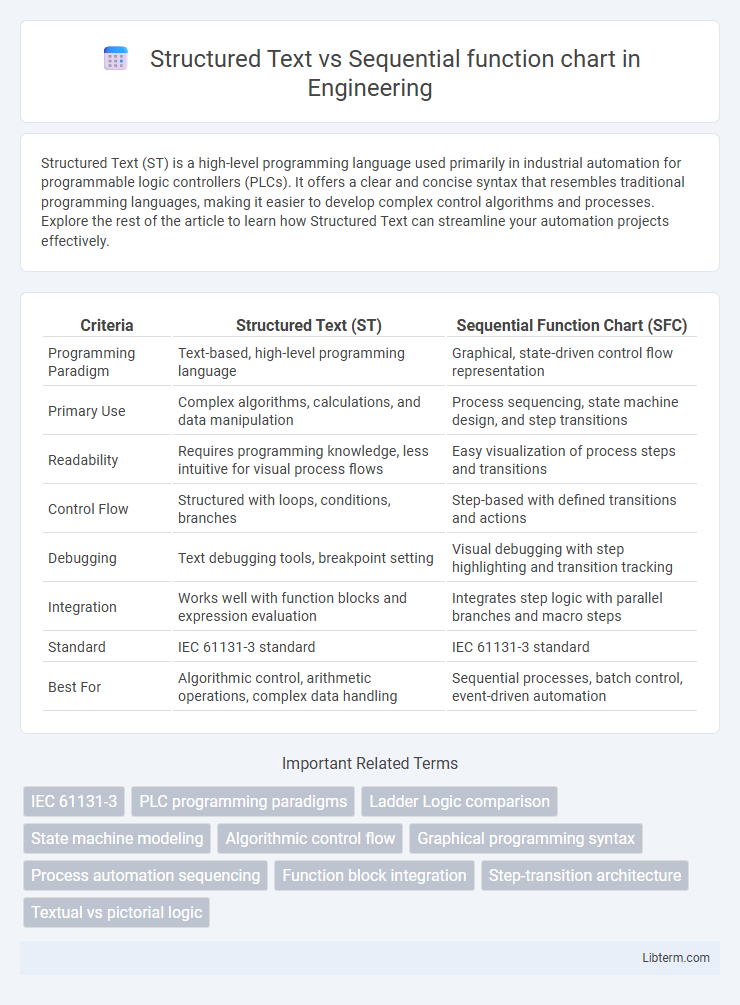Structured Text (ST) is a high-level programming language used primarily in industrial automation for programmable logic controllers (PLCs). It offers a clear and concise syntax that resembles traditional programming languages, making it easier to develop complex control algorithms and processes. Explore the rest of the article to learn how Structured Text can streamline your automation projects effectively.
Table of Comparison
| Criteria | Structured Text (ST) | Sequential Function Chart (SFC) |
|---|---|---|
| Programming Paradigm | Text-based, high-level programming language | Graphical, state-driven control flow representation |
| Primary Use | Complex algorithms, calculations, and data manipulation | Process sequencing, state machine design, and step transitions |
| Readability | Requires programming knowledge, less intuitive for visual process flows | Easy visualization of process steps and transitions |
| Control Flow | Structured with loops, conditions, branches | Step-based with defined transitions and actions |
| Debugging | Text debugging tools, breakpoint setting | Visual debugging with step highlighting and transition tracking |
| Integration | Works well with function blocks and expression evaluation | Integrates step logic with parallel branches and macro steps |
| Standard | IEC 61131-3 standard | IEC 61131-3 standard |
| Best For | Algorithmic control, arithmetic operations, complex data handling | Sequential processes, batch control, event-driven automation |
Introduction to Structured Text and Sequential Function Chart
Structured Text (ST) is a high-level programming language used in programmable logic controllers (PLCs) characterized by its similarity to traditional programming languages, enabling complex mathematical functions and conditional statements for automation tasks. Sequential Function Chart (SFC) is a graphical programming language designed to model sequential control processes by dividing operations into steps and transitions, improving readability and modularity in automation workflows. Both ST and SFC are part of the IEC 61131-3 standard, providing complementary approaches where ST offers detailed algorithmic control, and SFC facilitates structured process flow visualization.
Overview of IEC 61131-3 Programming Languages
Structured Text (ST) is a high-level, text-based programming language standardized under IEC 61131-3, offering powerful control flow structures and complex data handling for industrial automation. Sequential Function Chart (SFC) provides a graphical representation of sequential control processes, emphasizing the workflow and transition between steps in automation sequences. Both ST and SFC complement each other within the IEC 61131-3 framework, enabling flexible and efficient programming of programmable logic controllers (PLCs).
Key Features of Structured Text
Structured Text (ST) features high-level programming syntax that supports complex mathematical computations, conditional statements, and looping constructs, making it ideal for advanced automation tasks. It allows for clear, modular code organization with functions and function blocks, enhancing readability and maintainability in industrial control systems. Compared to Sequential Function Chart (SFC), Structured Text offers greater flexibility in algorithm design and is best suited for applications requiring detailed data processing and logic control.
Key Features of Sequential Function Chart
Sequential Function Chart (SFC) organizes control systems into steps, transitions, and actions, enabling clear visualization of process sequences. Its key features include parallel and alternative branching, which allow complex process flows to be represented efficiently. Unlike Structured Text, SFC offers intuitive graphical representation, making it easier to design and debug sequential operations in automation tasks.
Syntax Comparison: Structured Text vs Sequential Function Chart
Structured Text (ST) features a high-level, Pascal-like syntax optimized for complex algorithms with clear variable declarations and control structures such as IF-THEN-ELSE and FOR loops. Sequential Function Chart (SFC) uses a graphical syntax based on steps and transitions, allowing visual representation of process sequences and parallel activities, which enhances readability and modular design. ST offers precise code-based programming flexibility, while SFC emphasizes structured flow control through state transitions suitable for process automation.
Application Areas for ST and SFC
Structured Text (ST) excels in complex mathematical calculations, data handling, and algorithmic processes, making it ideal for applications in process control, batch management, and advanced automation systems. Sequential Function Chart (SFC) is best suited for sequential control tasks, state machine implementation, and procedural workflows, commonly used in manufacturing automation, packaging lines, and machine control where step-by-step execution is critical. ST offers flexibility for data-rich applications, while SFC provides clear visualization and management of sequential operations.
Advantages of Structured Text
Structured Text offers powerful advantages such as enhanced readability and ease of debugging compared to Sequential Function Chart. It supports complex algorithms and data manipulation through high-level programming constructs, enabling efficient control of sophisticated automation processes. The language's flexibility facilitates code reuse and modular programming, improving maintainability in large-scale industrial applications.
Advantages of Sequential Function Chart
Sequential Function Chart offers a visual and intuitive representation of complex control processes, making it easier to design, understand, and troubleshoot automation tasks compared to Structured Text. It supports parallel and conditional branching, allowing for more flexible and modular programming of sequential operations. This graphical approach enhances clarity in process flow and improves maintainability, especially in systems requiring step-by-step control and synchronization.
Limitations and Challenges
Structured Text offers high-level programming capabilities but struggles with readability and debugging complexity in large-scale automation projects. Sequential Function Chart provides clear visual process representation, yet it faces limitations in handling complex logic and interdependencies efficiently. Integrating both methods can mitigate their individual challenges, optimizing control system development and maintainability.
Choosing the Right Language for Your PLC Project
Choosing the right language for your PLC project depends on the complexity and readability requirements of the task. Structured Text excels in handling complex mathematical operations and data manipulation with its high-level, text-based programming style. Sequential Function Chart offers a visual approach to designing control sequences, enhancing clarity and easier debugging in step-by-step processes, making it ideal for projects requiring straightforward state transitions.
Structured Text Infographic

 libterm.com
libterm.com